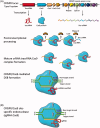Delivering CRISPR: a review of the challenges and approaches
- PMID: 29801422
- PMCID: PMC6058482
- DOI: 10.1080/10717544.2018.1474964
Delivering CRISPR: a review of the challenges and approaches
Abstract
Gene therapy has long held promise to correct a variety of human diseases and defects. Discovery of the Clustered Regularly-Interspaced Short Palindromic Repeats (CRISPR), the mechanism of the CRISPR-based prokaryotic adaptive immune system (CRISPR-associated system, Cas), and its repurposing into a potent gene editing tool has revolutionized the field of molecular biology and generated excitement for new and improved gene therapies. Additionally, the simplicity and flexibility of the CRISPR/Cas9 site-specific nuclease system has led to its widespread use in many biological research areas including development of model cell lines, discovering mechanisms of disease, identifying disease targets, development of transgene animals and plants, and transcriptional modulation. In this review, we present the brief history and basic mechanisms of the CRISPR/Cas9 system and its predecessors (ZFNs and TALENs), lessons learned from past human gene therapy efforts, and recent modifications of CRISPR/Cas9 to provide functions beyond gene editing. We introduce several factors that influence CRISPR/Cas9 efficacy which must be addressed before effective in vivo human gene therapy can be realized. The focus then turns to the most difficult barrier to potential in vivo use of CRISPR/Cas9, delivery. We detail the various cargos and delivery vehicles reported for CRISPR/Cas9, including physical delivery methods (e.g. microinjection; electroporation), viral delivery methods (e.g. adeno-associated virus (AAV); full-sized adenovirus and lentivirus), and non-viral delivery methods (e.g. liposomes; polyplexes; gold particles), and discuss their relative merits. We also examine several technologies that, while not currently reported for CRISPR/Cas9 delivery, appear to have promise in this field. The therapeutic potential of CRISPR/Cas9 is vast and will only increase as the technology and its delivery improves.
Keywords: CRISPR; Cas9; drug delivery; history; overview; prospective; review.
Figures








Similar articles
-
Delivery approaches for CRISPR/Cas9 therapeutics in vivo: advances and challenges.Expert Opin Drug Deliv. 2018 Sep;15(9):905-913. doi: 10.1080/17425247.2018.1517746. Epub 2018 Sep 12. Expert Opin Drug Deliv. 2018. PMID: 30169977 Free PMC article. Review.
-
Gene Therapy with CRISPR/Cas9 Coming to Age for HIV Cure.AIDS Rev. 2017 Oct-Dec;19(3):167-172. AIDS Rev. 2017. PMID: 29019352
-
CRISPR/Cas9 technology as a potent molecular tool for gene therapy.J Cell Physiol. 2019 Aug;234(8):12267-12277. doi: 10.1002/jcp.27972. Epub 2019 Jan 30. J Cell Physiol. 2019. PMID: 30697727 Review.
-
CRISPR/Cas9-Based Genome Editing for Disease Modeling and Therapy: Challenges and Opportunities for Nonviral Delivery.Chem Rev. 2017 Aug 9;117(15):9874-9906. doi: 10.1021/acs.chemrev.6b00799. Epub 2017 Jun 22. Chem Rev. 2017. PMID: 28640612 Review.
-
Advances in therapeutic application of CRISPR-Cas9.Brief Funct Genomics. 2020 May 20;19(3):164-174. doi: 10.1093/bfgp/elz031. Brief Funct Genomics. 2020. PMID: 31769791
Cited by
-
COVID-19: An overview on possible transmission ways, sampling matrices and diagnosis.Bioimpacts. 2024;14(6):29968. doi: 10.34172/bi.2024.29968. Epub 2024 Mar 12. Bioimpacts. 2024. PMID: 39493896 Free PMC article. Review.
-
The use of adenoviral vectors in gene therapy and vaccine approaches.Genet Mol Biol. 2022 Oct 7;45(3 Suppl 1):e20220079. doi: 10.1590/1678-4685-GMB-2022-0079. eCollection 2022. Genet Mol Biol. 2022. PMID: 36206378 Free PMC article.
-
Suppressing gain-of-function proteins via CRISPR/Cas9 system in SCA1 cells.Sci Rep. 2022 Nov 24;12(1):20285. doi: 10.1038/s41598-022-24299-y. Sci Rep. 2022. PMID: 36434031 Free PMC article.
-
Advances of Genome Editing with CRISPR/Cas9 in Neurodegeneration: The Right Path towards Therapy.Biomedicines. 2023 Dec 17;11(12):3333. doi: 10.3390/biomedicines11123333. Biomedicines. 2023. PMID: 38137554 Free PMC article. Review.
-
CRISPR-based knock-in mutagenesis of the pioneer transcription factor FOXA1: optimization of strategies for multi-allelic proteins in cancer cells.FEBS Open Bio. 2021 Jun;11(6):1537-1551. doi: 10.1002/2211-5463.13139. Epub 2021 Mar 20. FEBS Open Bio. 2021. PMID: 33666335 Free PMC article.
References
-
- Axford DS, Morris DP, McMurry JL. (2017). Cell penetrating peptide-mediated nuclear delivery of Cas9 to enhance the utility of CRISPR/Cas genome editing. FASEB J 31:909.4.
-
- Barrangou R, Fremaux C, Deveau H, et al. (2007). CRISPR provides acquired resistance against viruses in prokaryotes. Science 315:1709–12. - PubMed
Publication types
MeSH terms
LinkOut - more resources
Full Text Sources
Other Literature Sources
Miscellaneous
